gas type Hyundai Getz 2007 Owner's Manual
[x] Cancel search | Manufacturer: HYUNDAI, Model Year: 2007, Model line: Getz, Model: Hyundai Getz 2007Pages: 463, PDF Size: 11.14 MB
Page 14 of 463
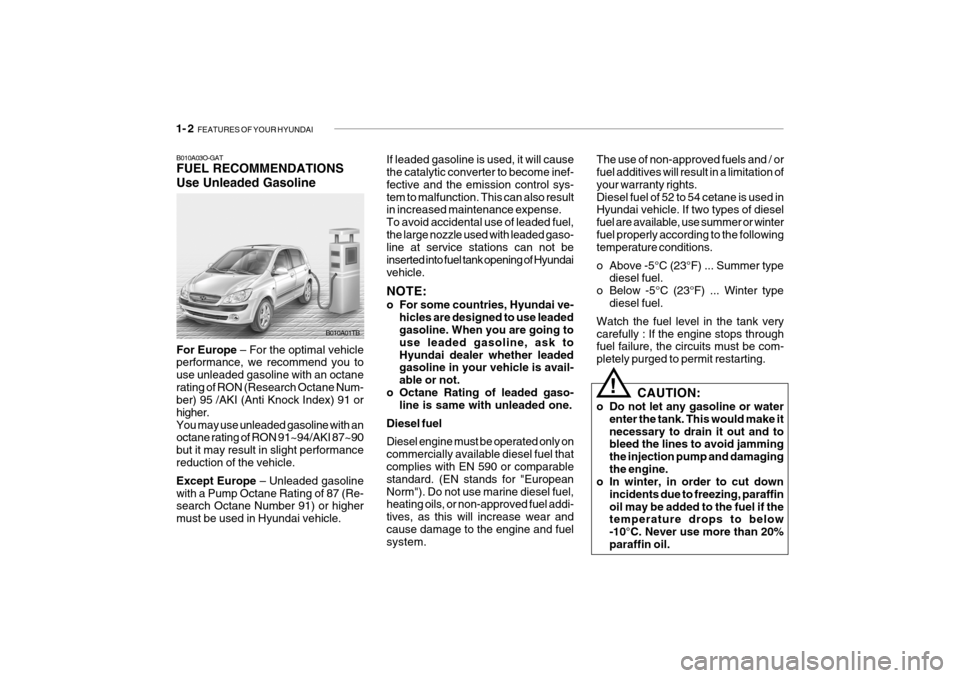
1- 2 FEATURES OF YOUR HYUNDAI
B010A03O-GAT FUEL RECOMMENDATIONS Use Unleaded Gasoline If leaded gasoline is used, it will cause the catalytic converter to become inef- fective and the emission control sys-tem to malfunction. This can also result in increased maintenance expense. To avoid accidental use of leaded fuel,the large nozzle used with leaded gaso- line at service stations can not be inserted into fuel tank opening of Hyundaivehicle. NOTE:
o For some countries, Hyundai ve-
hicles are designed to use leaded gasoline. When you are going to use leaded gasoline, ask toHyundai dealer whether leaded gasoline in your vehicle is avail- able or not.
o Octane Rating of leaded gaso- line is same with unleaded one.
Diesel fuel Diesel engine must be operated only on commercially available diesel fuel that complies with EN 590 or comparable standard. (EN stands for "EuropeanNorm"). Do not use marine diesel fuel, heating oils, or non-approved fuel addi- tives, as this will increase wear andcause damage to the engine and fuel system.
For Europe
– For the optimal vehicle
performance, we recommend you to use unleaded gasoline with an octanerating of RON (Research Octane Num- ber) 95 /AKI (Anti Knock Index) 91 or higher.You may use unleaded gasoline with an octane rating of RON 91~94/AKI 87~90 but it may result in slight performancereduction of the vehicle. Except Europe – Unleaded gasoline
with a Pump Octane Rating of 87 (Re- search Octane Number 91) or higher must be used in Hyundai vehicle. B010A01TB
CAUTION:
o Do not let any gasoline or water enter the tank. This would make itnecessary to drain it out and to bleed the lines to avoid jamming the injection pump and damagingthe engine.
o In winter, in order to cut down
incidents due to freezing, paraffinoil may be added to the fuel if the temperature drops to below -10°C. Never use more than 20%paraffin oil.
!
The use of non-approved fuels and / or fuel additives will result in a limitation of your warranty rights.Diesel fuel of 52 to 54 cetane is used in Hyundai vehicle. If two types of diesel fuel are available, use summer or winterfuel properly according to the following temperature conditions.
o Above -5°C (23°F) ... Summer type
diesel fuel.
o Below -5°C (23°F) ... Winter type diesel fuel.
Watch the fuel level in the tank very carefully : If the engine stops through fuel failure, the circuits must be com- pletely purged to permit restarting.
Page 15 of 463
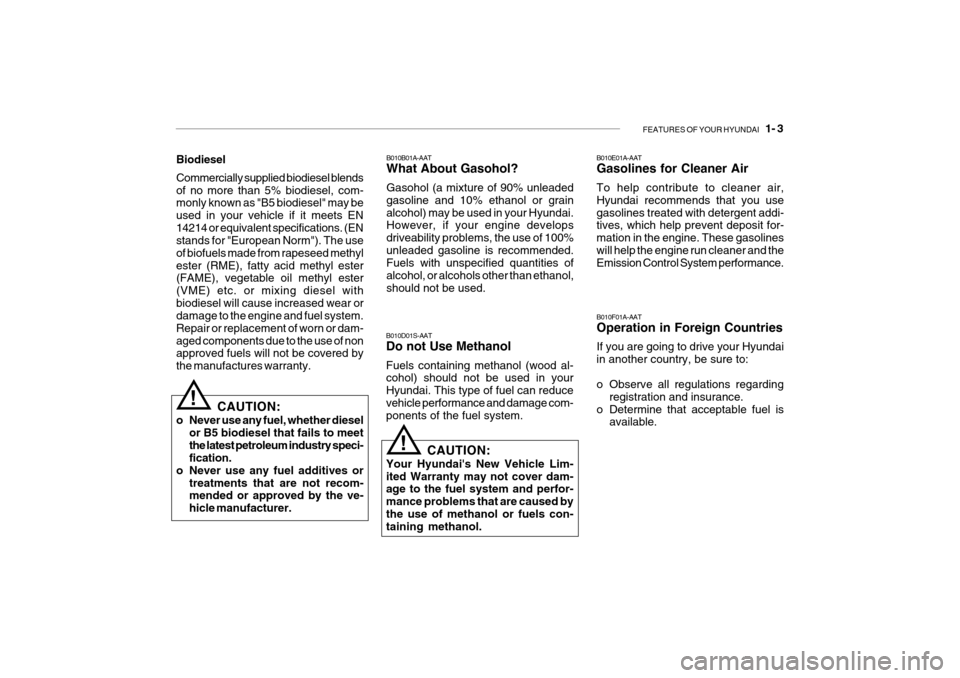
FEATURES OF YOUR HYUNDAI 1- 3
B010B01A-AAT What About Gasohol? Gasohol (a mixture of 90% unleaded gasoline and 10% ethanol or grainalcohol) may be used in your Hyundai. However, if your engine develops driveability problems, the use of 100%unleaded gasoline is recommended. Fuels with unspecified quantities of alcohol, or alcohols other than ethanol,should not be used.
Biodiesel Commercially supplied biodiesel blends of no more than 5% biodiesel, com- monly known as "B5 biodiesel" may be used in your vehicle if it meets EN14214 or equivalent specifications. (EN stands for "European Norm"). The use of biofuels made from rapeseed methylester (RME), fatty acid methyl ester (FAME), vegetable oil methyl ester (VME) etc. or mixing diesel withbiodiesel will cause increased wear or damage to the engine and fuel system. Repair or replacement of worn or dam-aged components due to the use of non approved fuels will not be covered by the manufactures warranty.
CAUTION:
o Never use any fuel, whether diesel or B5 biodiesel that fails to meetthe latest petroleum industry speci- fication.
o Never use any fuel additives or treatments that are not recom-mended or approved by the ve- hicle manufacturer.
! B010D01S-AAT Do not Use Methanol Fuels containing methanol (wood al- cohol) should not be used in your Hyundai. This type of fuel can reducevehicle performance and damage com- ponents of the fuel system.
CAUTION:
Your Hyundai's New Vehicle Lim- ited Warranty may not cover dam- age to the fuel system and perfor- mance problems that are caused bythe use of methanol or fuels con- taining methanol.
! B010E01A-AAT Gasolines for Cleaner Air To help contribute to cleaner air, Hyundai recommends that you usegasolines treated with detergent addi- tives, which help prevent deposit for- mation in the engine. These gasolineswill help the engine run cleaner and the Emission Control System performance. B010F01A-AAT Operation in Foreign Countries If you are going to drive your Hyundai in another country, be sure to:
o Observe all regulations regarding
registration and insurance.
o Determine that acceptable fuel is available.
Page 183 of 463

4- 6 CORROSION PREVENTION AND APPEARANCE CARE
E040D01A-AAT Cleaning the Seat Belts To clean the seat belts, use a cloth or sponge with mild soap or detergent and warm water. Do not use strongdetergents, dye, bleach or abrasive materials on the seat belts as this may weaken the fabric.While cleaning the belts, inspect them for excessive wear, cuts, fraying or other signs of damage and replacethem if necessary.
E040C01A-AAT Cleaning the Carpets Use a foam-type carpet cleaner. Clean- ers of this type are available in aerosolcans in liquid form or powder. Read the instructions and follow them exactly. Using a vacuum cleaner with the ap-propriate attachment, remove as much dirt from the carpets as possible. Apply the foam following the manufacturer'sdirections, then rub in overlapping circles. Do not add water. These clean- ers work best when the carpet is keptas dry as possible.
will keep your leather lustrous, beautiful and ensure you have many years of wear.Take a piece of cheese cloth and using any mild soap and lukewarm water, work up a good lather. Thoroughlywash the leather. Wipe clean with a slightly damp cloth and dry with soft cloth. Do this as often as the leatherbecomes soiled. During tanning operations, sufficient oils are incorporated through process- ing that none need be applied during the life of the leather. Oil applied to thefinished surface will in no way help the leather and may do more harm than good. Varnishes and furniture polishesshould never be used under any con- ditions.
E040A01A-AAT CLEANING THE INTERIOR To Clean the Vinyl Upholstery To clean the vinyl upholstery, first re- move loose dirt and dust with a vacuum cleaner. Then apply a solution of mildsoap or detergent and water using a clean sponge or soft cloth. Allow this to stay on the surface to loosen the dirt,then wipe with a clean damp sponge or cloth. If all the dirt stains are not re- moved, repeat this procedure until theupholstery is clean. Do not use gaso- line, solvent, paint thinner or other strong cleaners. E040B01A-AAT To Clean the Leather Upholstery (If installed) In the normal course of use, leather upholstered surfaces will, like any material, pick-up dust and dirt. This dust and dirt must be cleaned off or itmay work into the surface of the leather, causing damage. Fine leather needs care, and should be cleaned when necessary. Washing leather thoroughly with soap and water
Page 205 of 463
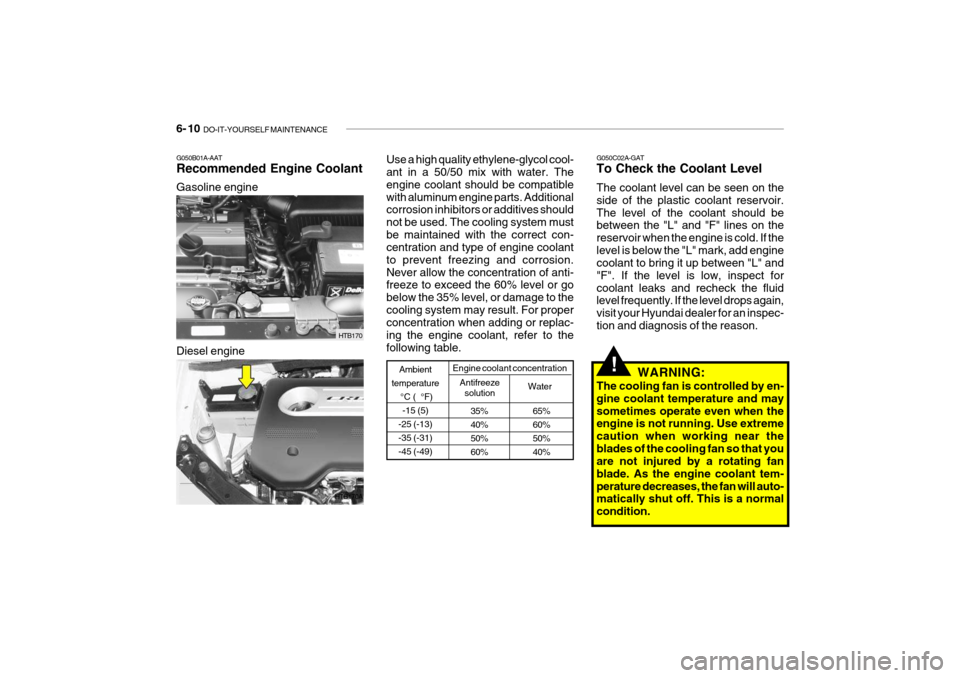
6- 10 DO-IT-YOURSELF MAINTENANCE
G050C02A-GAT To Check the Coolant Level The coolant level can be seen on the side of the plastic coolant reservoir.The level of the coolant should be between the "L" and "F" lines on the reservoir when the engine is cold. If thelevel is below the "L" mark, add engine coolant to bring it up between "L" and "F". If the level is low, inspect forcoolant leaks and recheck the fluid level frequently. If the level drops again, visit your Hyundai dealer for an inspec-tion and diagnosis of the reason.
HTB170
HTB170A
Gasoline engine Diesel engine
G050B01A-AAT Recommended Engine Coolant
Use a high quality ethylene-glycol cool- ant in a 50/50 mix with water. The engine coolant should be compatiblewith aluminum engine parts. Additional corrosion inhibitors or additives should not be used. The cooling system mustbe maintained with the correct con- centration and type of engine coolant to prevent freezing and corrosion.Never allow the concentration of anti- freeze to exceed the 60% level or go below the 35% level, or damage to thecooling system may result. For proper concentration when adding or replac- ing the engine coolant, refer to thefollowing table.
35% 40%50%60%
Ambient
temperature °C ( °F)-15 (5)
-25 (-13)-35 (-31)-45 (-49)
Antifreeze solution Water
Engine coolant concentration
65% 60%50%40% WARNING:
The cooling fan is controlled by en- gine coolant temperature and maysometimes operate even when the engine is not running. Use extreme caution when working near theblades of the cooling fan so that you are not injured by a rotating fan blade. As the engine coolant tem-perature decreases, the fan will auto- matically shut off. This is a normal condition.
!
Page 237 of 463
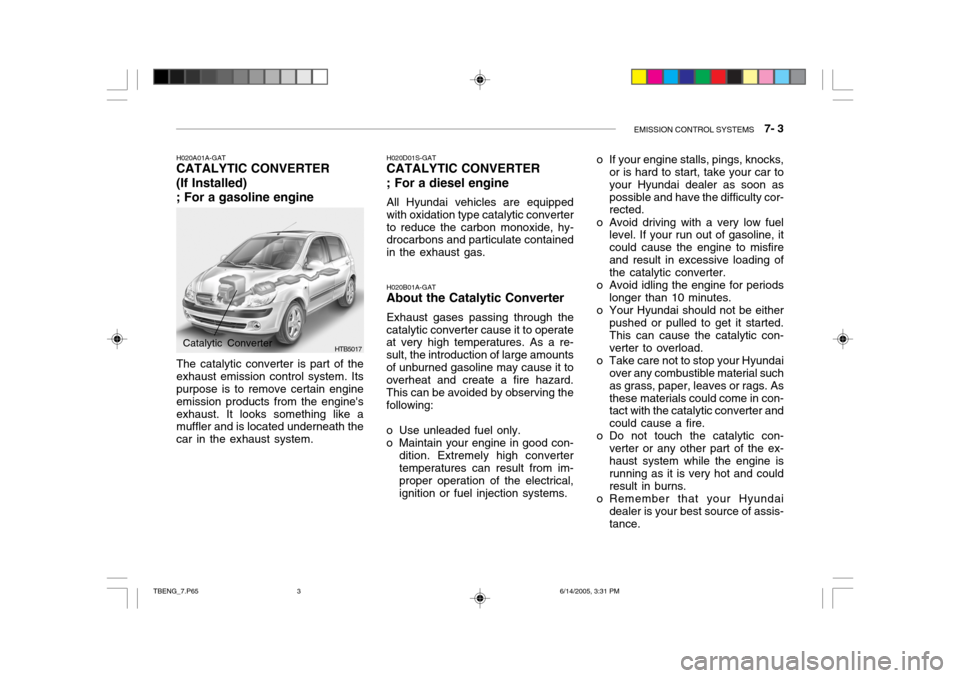
EMISSION CONTROL SYSTEMS 7- 3
H020A01A-GAT
CATALYTIC CONVERTER (If Installed) ; For a gasoline engine
HTB5017
The catalytic converter is part of the exhaust emission control system. Its purpose is to remove certain engine emission products from the engine'sexhaust. It looks something like a muffler and is located underneath the car in the exhaust system.
Catalytic Converter H020B01A-GAT
About the Catalytic Converter
Exhaust gases passing through the
catalytic converter cause it to operate at very high temperatures. As a re- sult, the introduction of large amountsof unburned gasoline may cause it to overheat and create a fire hazard. This can be avoided by observing thefollowing:
o Use unleaded fuel only.
o Maintain your engine in good con-
dition. Extremely high converter temperatures can result from im- proper operation of the electrical,ignition or fuel injection systems.
H020D01S-GAT CATALYTIC CONVERTER ; For a diesel engine All Hyundai vehicles are equipped with oxidation type catalytic converterto reduce the carbon monoxide, hy- drocarbons and particulate contained in the exhaust gas.
o If your engine stalls, pings, knocks,
or is hard to start, take your car toyour Hyundai dealer as soon aspossible and have the difficulty cor- rected.
o Avoid driving with a very low fuel level. If your run out of gasoline, it could cause the engine to misfireand result in excessive loading of the catalytic converter.
o Avoid idling the engine for periods longer than 10 minutes.
o Your Hyundai should not be either pushed or pulled to get it started.This can cause the catalytic con- verter to overload.
o Take care not to stop your Hyundai over any combustible material suchas grass, paper, leaves or rags. Asthese materials could come in con- tact with the catalytic converter and could cause a fire.
o Do not touch the catalytic con-
verter or any other part of the ex-haust system while the engine is running as it is very hot and could result in burns.
o Remember that your Hyundai dealer is your best source of assis-tance.
TBENG_7.P65 6/14/2005, 3:31 PM
3
Page 247 of 463

VEHICLE SPECIFICATIONS 9- 3
700 ± 100
BTDC 5° ± 5°
GASOLINE
1-3-4-2 1.4 L
75.5 x 78.1 1,399
- -
1.1 L
67 x 77 1,086
0.13 mm0.17 mm
850 ± 100
BTDC 3° ± 5° 1.6 L
76.5 x 87 1,599
- -
Engine TypeBore x Stroke Displacement (cc) Firing order/Injection orderValve clearance (Cold Engine 20 ± 5°C) Idle speed (RPM)Ignition timing (Base)/Injection timing
IntakeExhaust
J070A03TB-GAT ENGINE
DIESEL
1.5L
4-Cylinder in -line DOHC
75 x 84,51,493
1-3-4-2
- --
Auto control
ITEMS
4-Cylinder in -line SOHC 4-Cylinder in -line DOHC
Page 268 of 463
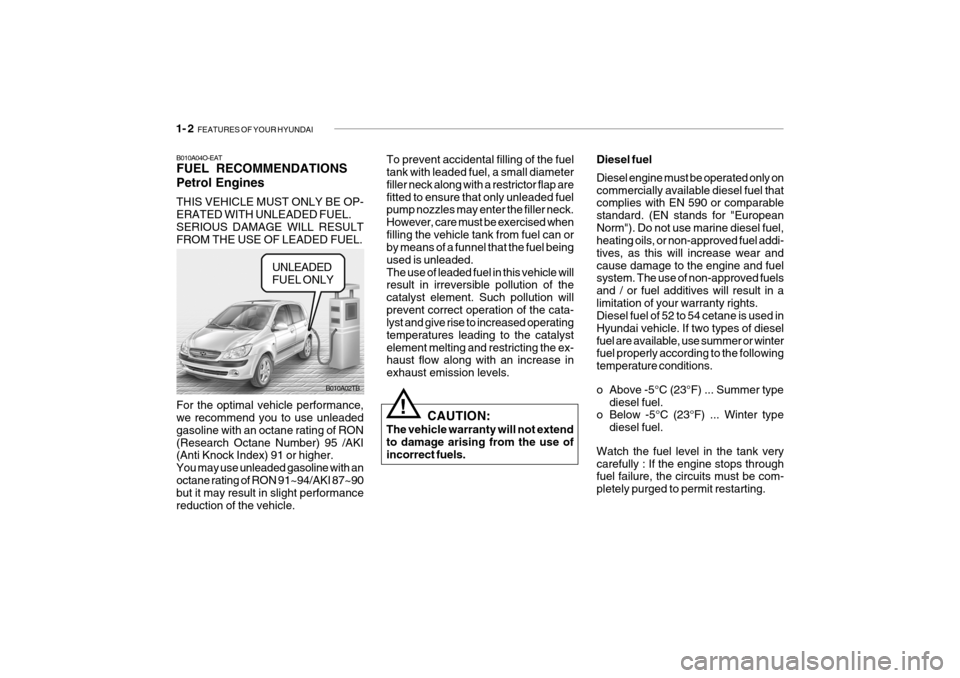
1- 2 FEATURES OF YOUR HYUNDAI
B010A04O-EAT FUEL RECOMMENDATIONS Petrol Engines THIS VEHICLE MUST ONLY BE OP- ERATED WITH UNLEADED FUEL. SERIOUS DAMAGE WILL RESULTFROM THE USE OF LEADED FUEL. To prevent accidental filling of the fuel tank with leaded fuel, a small diameter filler neck along with a restrictor flap arefitted to ensure that only unleaded fuel pump nozzles may enter the filler neck. However, care must be exercised whenfilling the vehicle tank from fuel can or by means of a funnel that the fuel being used is unleaded.The use of leaded fuel in this vehicle will result in irreversible pollution of the catalyst element. Such pollution willprevent correct operation of the cata- lyst and give rise to increased operating temperatures leading to the catalystelement melting and restricting the ex- haust flow along with an increase in exhaust emission levels.
For the optimal vehicle performance, we recommend you to use unleaded gasoline with an octane rating of RON(Research Octane Number) 95 /AKI (Anti Knock Index) 91 or higher. You may use unleaded gasoline with anoctane rating of RON 91~94/AKI 87~90 but it may result in slight performance reduction of the vehicle. B010A02TB
CAUTION:
The vehicle warranty will not extendto damage arising from the use of incorrect fuels.
! Diesel fuel Diesel engine must be operated only on commercially available diesel fuel that complies with EN 590 or comparable standard. (EN stands for "EuropeanNorm"). Do not use marine diesel fuel, heating oils, or non-approved fuel addi- tives, as this will increase wear andcause damage to the engine and fuel system. The use of non-approved fuels and / or fuel additives will result in alimitation of your warranty rights. Diesel fuel of 52 to 54 cetane is used in Hyundai vehicle. If two types of dieselfuel are available, use summer or winter fuel properly according to the following temperature conditions.
o Above -5°C (23°F) ... Summer type
diesel fuel.
o Below -5°C (23°F) ... Winter type
diesel fuel.
Watch the fuel level in the tank very carefully : If the engine stops through fuel failure, the circuits must be com- pletely purged to permit restarting.
UNLEADEDFUEL ONLY
Page 269 of 463
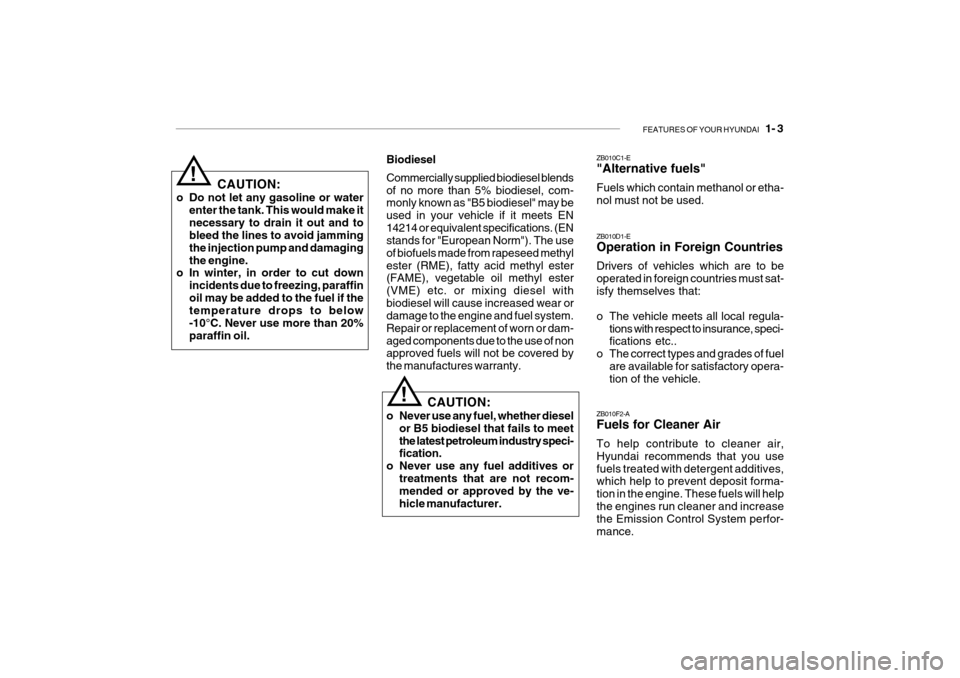
FEATURES OF YOUR HYUNDAI 1- 3
!
CAUTION:
o Do not let any gasoline or water enter the tank. This would make it necessary to drain it out and to bleed the lines to avoid jamming the injection pump and damagingthe engine.
o In winter, in order to cut down
incidents due to freezing, paraffinoil may be added to the fuel if the temperature drops to below -10°C. Never use more than 20%paraffin oil. Biodiesel Commercially supplied biodiesel blends of no more than 5% biodiesel, com- monly known as "B5 biodiesel" may be used in your vehicle if it meets EN14214 or equivalent specifications. (EN stands for "European Norm"). The use of biofuels made from rapeseed methylester (RME), fatty acid methyl ester (FAME), vegetable oil methyl ester (VME) etc. or mixing diesel withbiodiesel will cause increased wear or damage to the engine and fuel system. Repair or replacement of worn or dam-aged components due to the use of non approved fuels will not be covered by the manufactures warranty.
CAUTION:
o Never use any fuel, whether diesel or B5 biodiesel that fails to meetthe latest petroleum industry speci- fication.
o Never use any fuel additives or treatments that are not recom-mended or approved by the ve- hicle manufacturer.
! ZB010C1-E "Alternative fuels" Fuels which contain methanol or etha- nol must not be used. ZB010F2-A Fuels for Cleaner Air To help contribute to cleaner air, Hyundai recommends that you usefuels treated with detergent additives, which help to prevent deposit forma- tion in the engine. These fuels will helpthe engines run cleaner and increase the Emission Control System perfor- mance.
ZB010D1-E Operation in Foreign Countries Drivers of vehicles which are to be operated in foreign countries must sat-isfy themselves that:
o The vehicle meets all local regula-
tions with respect to insurance, speci- fications etc..
o The correct types and grades of fuel are available for satisfactory opera-tion of the vehicle.
Page 385 of 463
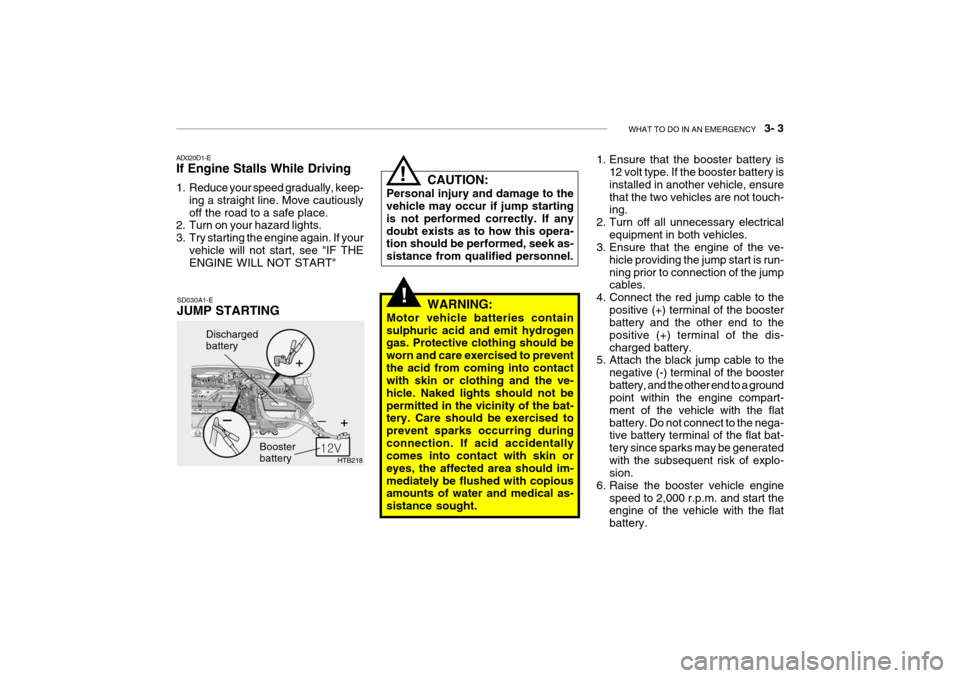
WHAT TO DO IN AN EMERGENCY 3- 3
!
HTB218
Discharged battery
Booster battery
CAUTION:
Personal injury and damage to the vehicle may occur if jump starting is not performed correctly. If anydoubt exists as to how this opera- tion should be performed, seek as- sistance from qualified personnel.
SD030A1-E JUMP STARTING
AD020D1-EIf Engine Stalls While Driving
1. Reduce your speed gradually, keep-
ing a straight line. Move cautiously off the road to a safe place.
2. Turn on your hazard lights.
3. Try starting the engine again. If your
vehicle will not start, see "IF THE ENGINE WILL NOT START"!
WARNING:
Motor vehicle batteries contain sulphuric acid and emit hydrogen gas. Protective clothing should be worn and care exercised to preventthe acid from coming into contact with skin or clothing and the ve- hicle. Naked lights should not bepermitted in the vicinity of the bat- tery. Care should be exercised to prevent sparks occurring duringconnection. If acid accidentally comes into contact with skin or eyes, the affected area should im-mediately be flushed with copious amounts of water and medical as- sistance sought. 1. Ensure that the booster battery is
12 volt type. If the booster battery isinstalled in another vehicle, ensurethat the two vehicles are not touch- ing.
2. Turn off all unnecessary electrical equipment in both vehicles.
3. Ensure that the engine of the ve-
hicle providing the jump start is run- ning prior to connection of the jump cables.
4. Connect the red jump cable to the positive (+) terminal of the boosterbattery and the other end to the positive (+) terminal of the dis-charged battery.
5. Attach the black jump cable to the
negative (-) terminal of the boosterbattery, and the other end to a ground point within the engine compart- ment of the vehicle with the flatbattery. Do not connect to the nega- tive battery terminal of the flat bat- tery since sparks may be generatedwith the subsequent risk of explo- sion.
6. Raise the booster vehicle engine speed to 2,000 r.p.m. and start theengine of the vehicle with the flat battery.
Page 433 of 463
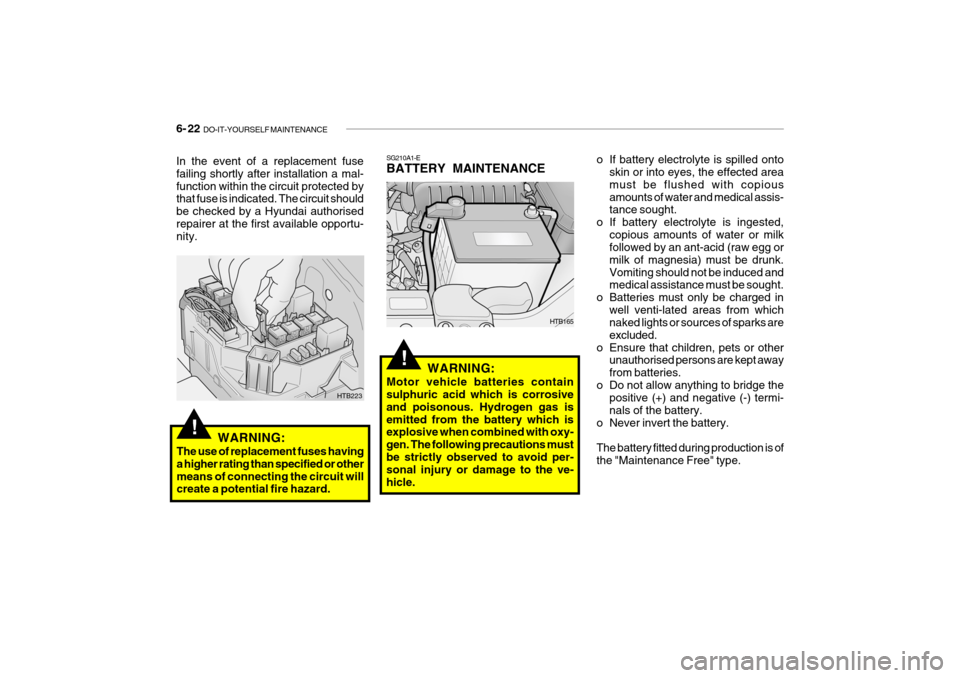
6- 22 DO-IT-YOURSELF MAINTENANCE
!
o If battery electrolyte is spilled onto
skin or into eyes, the effected area must be flushed with copiousamounts of water and medical assis- tance sought.
o If battery electrolyte is ingested, copious amounts of water or milkfollowed by an ant-acid (raw egg or milk of magnesia) must be drunk.Vomiting should not be induced and medical assistance must be sought.
o Batteries must only be charged in well venti-lated areas from whichnaked lights or sources of sparks are excluded.
o Ensure that children, pets or other unauthorised persons are kept awayfrom batteries.
o Do not allow anything to bridge the positive (+) and negative (-) termi-nals of the battery.
o Never invert the battery. The battery fitted during production is of the "Maintenance Free" type.
SG210A1-E BATTERY MAINTENANCE
WARNING:
Motor vehicle batteries contain sulphuric acid which is corrosive and poisonous. Hydrogen gas isemitted from the battery which is explosive when combined with oxy- gen. The following precautions mustbe strictly observed to avoid per- sonal injury or damage to the ve- hicle.
HTB165
!
HTB223
WARNING:
The use of replacement fuses having a higher rating than specified or othermeans of connecting the circuit will create a potential fire hazard.
In the event of a replacement fuse failing shortly after installation a mal-function within the circuit protected by that fuse is indicated. The circuit should be checked by a Hyundai authorisedrepairer at the first available opportu- nity.